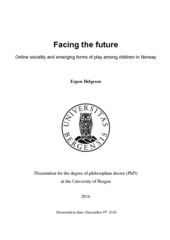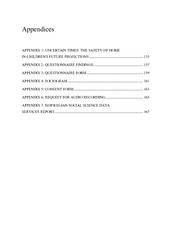| dc.contributor.author | Helgesen, Espen | |
| dc.date.accessioned | 2017-03-10T09:57:39Z | |
| dc.date.available | 2017-03-10T09:57:39Z | |
| dc.date.issued | 2016-12-09 | |
| dc.identifier.isbn | 978-82-308-3174-8 | |
| dc.identifier.uri | https://hdl.handle.net/1956/15578 | |
| dc.description.abstract | Young people in Norway have never experienced a world without the internet. This thesis explores uses of digital technology in children’s lives, and draws on fieldwork among eight- and nine-year olds in Kristiansand to identify emerging forms of sociality and play in online and offline literacy practices. In Norway, where internet access is near universal, children’s immersion into digital environments raises new questions concerning central theoretical concepts in anthropology. What conceptual tools are required for making sense of the ongoing merging of online and offline sociality? How can we deal analytically with the rapidly shifting contexts of children’s play? The thesis addresses these questions through an ethnographic investigation of how children employ avatars—or digital bodies—as they playfully inhabit online worlds with their friends. Play is an elusive phenomenon; easily recognizable, yet highly resistant to definitional attempts. This thesis employs a phenomenological approach to play, and draws on children’s engagement with masks, avatars, and toys to develop a concept of play understood as an attitude of openness to the new and unexpected. Far from being limited to non-serious activities, play has the capacity to bring people face to face with fundamental paradoxes of human existence. Taking children’s engagement with cosplay—or costume play—as a point of departure, the ethnographic data presented here shows how playful masking offers paradoxical viewpoints situated between human and non-human perspectives. Expanding on the anthropological literature on animism, the thesis argues that children’s contemporary play in Norway involves an oscillation between techno-animist and techno-naturalist perspectives. The thesis also suggests that the most relevant sites for understanding people’s engagement with the internet are not necessarily found online. The recent proliferation of online worlds has had a significant impact on children’s literacy practices in Norway. Alphabetic text suffuses online sociality, and familiarity with alphabetic literacy is frequently a prerequisite for participation online. Digital literacy practices often take place outside the adult gaze, where creativity and artful expression are valued above grammar and spelling conventions. The thesis explores the central role of alphabetic text in children’s online filmmaking. Through playful juxtapositions of images and text, filmmakers conjure up future images that emerge not as abstract horizons, but as fully real and with palpable effects. Starting from the premise that literacy, far from being a neutral set of skills, is an inherently social technology, this thesis contributes to our understanding of how children in Norway become literate during a period of rapid technological change. As young people increasingly surpass older generations with regards to digital competence, acknowledging children’s active part in shaping sociality appears more important than ever. Numerous scholars of childhood have pointed out that children, rather than being considered passive adults-in-the-making, should be taken seriously as social beings in their own right. While acknowledging the importance of viewing children as social beings, this thesis also suggests that the analytical shift in childhood studies from becoming to being has tended to ignore the multiple becomings in children’s lives that are not directly related to their imagined future adulthood. Facing the future, children grow outwards as well as up as they employ digital technologies to playfully create new worlds. As digital literacy practices accommodate new forms of sociality and play, young people in contemporary Norway experience a world where there is far more to the future than becoming adult. | en_US |
| dc.language.iso | eng | eng |
| dc.publisher | The University of Bergen | eng |
| dc.relation.haspart | Article 1: Helgesen, Espen. 2015. “Miku’s Mask: Fictional Encounters in Children’s Costume Play”. Childhood: A Journal of Global Child Research, Vol. 22(4): 536–550. The article is available at: <a href="http://hdl.handle.net/1956/9049" target="blank">http://hdl.handle.net/1956/9049</a> | eng |
| dc.relation.haspart | Article 2: Helgesen, Espen. 2016. “Crafting Future Selves: Time-Tricking and the Limits of Temporal Play in Children’s Online Filmmaking”. Cambridge Journal of Anthropology, Vol. 34(1): 87–99. The article is not available in BORA due to publisher restrictions. The published version is available at: <a href="https://doi.org/10.3167/ca.2016.340109" target="blank"> https://doi.org/10.3167/ca.2016.340109</a> | eng |
| dc.relation.haspart | Article 3: Helgesen, Espen. “Fragile Avatars: Playful Betrayal in Children’s Online Hacking Practices”. The article is not available in BORA. | eng |
| dc.relation.haspart | Article 4: Helgesen, Espen. 2015. “Usikre tider: Hjemmets trygghet i barns fremtidsforestillinger”. Norsk Antropologisk Tidsskrift, Vol. 26(3-4): 255–267. The article is not available in BORA due to publisher restrictions. The published version is available at: <a href=" https://www.idunn.no/nat/2015/03-04/usikre_tider_hjemmets_trygghet_i_barns_fremtidsforestillin" target="blank"> https://www.idunn.no/nat/2015/03-04/usikre_tider_hjemmets_trygghet_i_barns_fremtidsforestillin</a>. An English translation is available in the appendices. | eng |
| dc.title | Facing the Future. Online Sociality and Emerging Forms of Play among Children in Norway | eng |
| dc.type | Doctoral thesis | en_US |
| dc.rights.holder | Copyright the author. All rights reserved. | en_US |
| dc.identifier.cristin | 1407465 | |

